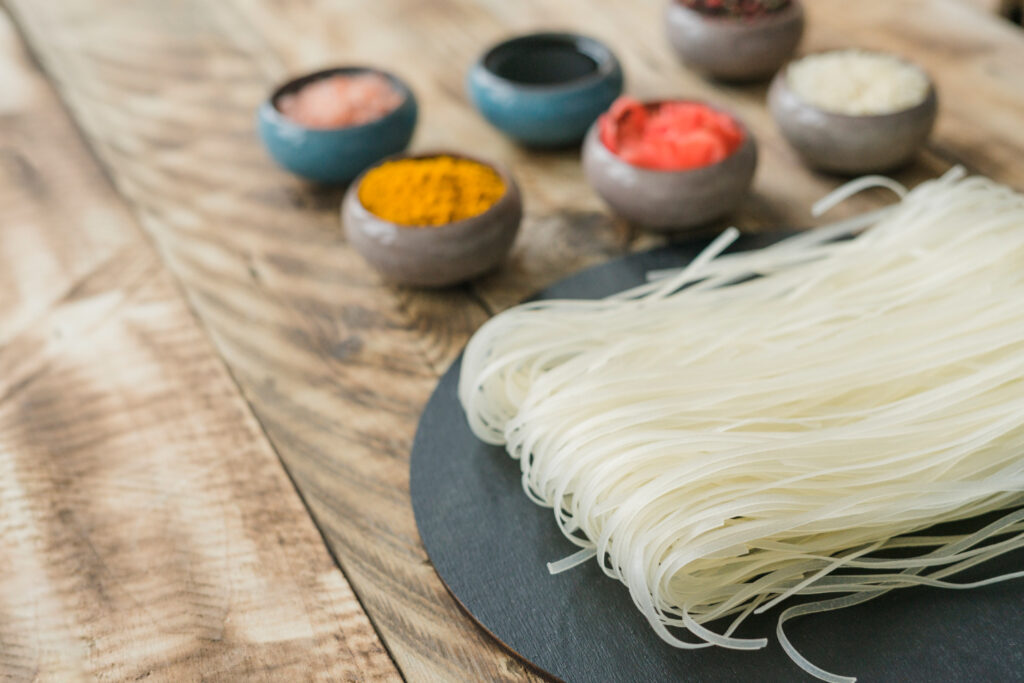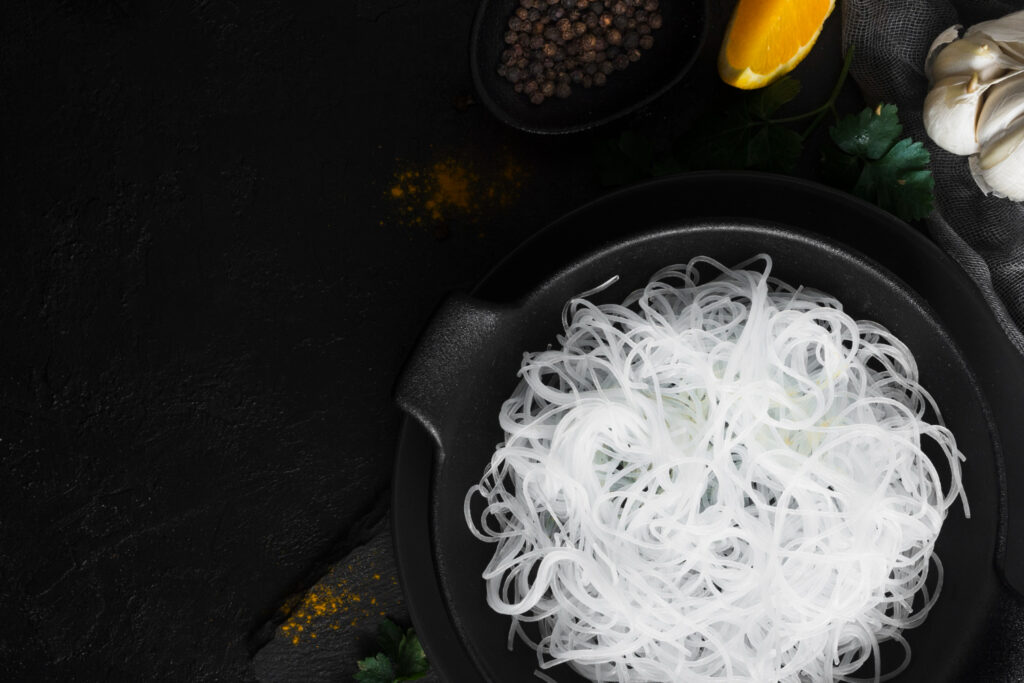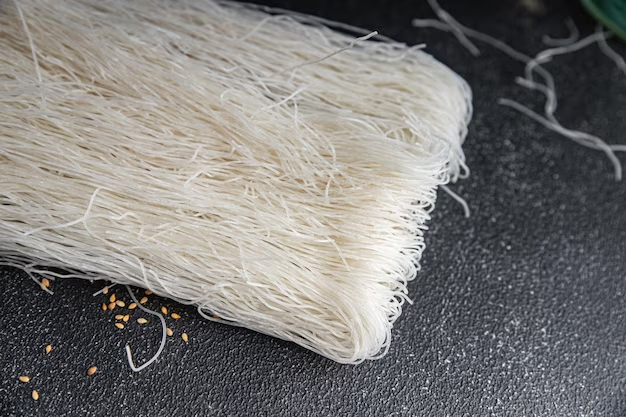As someone who loves to travel and explore different cuisines, I’ve discovered that rice noodles are a staple in many Asian dishes. However, how to cook rice noodles properly can be a challenge, especially if you’re not familiar with the different types and cooking methods.
Through my own experiences and travels, I’ve developed a passion for mastering the art of cooking rice noodles. I’ll share with you my tips and techniques for preparing, cooking, and serving delicious rice noodle dishes that will impress your taste buds and those of your family and friends.
What are rice noodles?

Rice noodles are a type of noodle made from rice flour and water. They are commonly used in many Asian cuisines, including Thai, Vietnamese, and Chinese dishes. Rice noodles come in different sizes and shapes, such as vermicelli, pad thai noodles, and thick noodles for soups.
Learning how to cook rice noodles is important because it allows you to create a variety of delicious and healthy dishes that are gluten-free and low in fat.
With the right techniques, rice noodles can be cooked to perfection, retaining their texture and flavor. Before cooking rice noodles, it’s important to prepare them by soaking them in water to soften them. Additionally, it’s important to choose the right type of rice noodles for your dish, depending on the recipe and cooking method.
What types of rice noodles?
There are several types of rice noodles that vary in shape, size, and texture. Here are some of the most common types:
- Vermicelli noodles: Thin, long and delicate noodles that are often used in pho, salads and stir-fries.
- Pad Thai noodles: Flat and wide noodles that are commonly used in the popular Thai dish, Pad Thai.
- Rice stick noodles: Flat and thin noodles that come in different widths and are often used in Hu tieu nam vang.
- Rice noodles sheets: Wide, flat and thin noodles that are used in dishes like Vietnamese spring rolls and noodle rolls.
- Rice udon noodles: Thick, chewy and soft noodles that are used in Japanese cuisine, particularly in soups.
- Glass noodles: Also known as cellophane noodles, these are thin and transparent noodles that are commonly used in soups and stir-fries, you’ll often see it in mien ga.
These are just a few examples of the many types of rice noodles available, each with their own unique characteristics that make them suitable for different dishes and cooking methods.
How to cook rice noodles?

Before starting, it’s important to read the instructions on the package of your specific brand of rice noodles, as different brands may require slightly different cooking times, here is a recipe for cooking rice noodles:
Cooking note
- Yield: 4 servings
- Prep Time: 15 minutes
- Cook Time: 10 minutes
- Total Time: 25 minutes
- Course: Main Dish
- Cuisine: Vietnamese
Equipment
- Large pot
- Strainer or colander
- Large mixing bowl
- Medium saucepan
- Tongs or chopstick
Ingredients
- 8 oz. rice noodles
- 4 cups water
- 1 tsp. salt
- 1 tbsp. vegetable oil
How to cook rice noodles?
Are you wondering about “how to cook rice noodles?” and how to cook rice noodles so that they don’t stick if you wonder, then you should follow the steps below to get a delicious and non-sticky rice noodle product.
- Bring 4 cups of water to a boil in a large pot. Add 1 teaspoon of salt to the water.
- Add the rice noodles to the pot, and use tongs or a fork to separate the noodles.
- Let the noodles cook for 5-10 minutes, or until they are tender but not mushy. The cooking time will depend on the thickness of the noodles.
- Once the noodles are done, remove the pot from the heat and pour the contents through a colander to drain the water.
- Rinse the noodles with cold water to stop them from cooking any further and to prevent them from sticking together.
- Add 1 tablespoon of vegetable oil to the noodles and toss them lightly to coat the noodles with oil.
Soaking Rice Noodles
Soaking rice noodles is an important step in preparing many Asian dishes, especially Vietnamese, Thai, and Chinese cuisine. Rice noodles are delicate and dry, and they need to be soaked before cooking to soften and rehydrate them.
Soaking also helps to remove excess starch from the noodles, which can make them sticky and clump together when cooked, and this is how to soak rice noodles properly:
- Place the rice noodles in a large bowl or pot.
- Cover the noodles with warm water. The water should be warm, but not too hot, as this can overcook and break down the noodles.
- Use a fork or tongs to gently separate and stir the noodles, ensuring that they are fully submerged in the water.
- Soak the noodles for 15–30 minutes, or until they are pliable and soft but still slightly firm. Be careful not to over-soak the noodles, as they can become mushy and lose their texture.
- Drain the noodles in a colander or strainer, and rinse them with cold water to stop the cooking process and remove any excess starch.
Different cooking methods for rice noodles
Cooking rice noodles also has many different cooking methods, so please refer to which method of cooking rice noodles will make it easier for you to cook.
- Boiling: As described above, boiling is the most common method for cooking rice noodles.
- Stir-frying: Rice noodles can also be stir-fried with vegetables, meat, and sauces for a quick and easy meal.
- Soup: Rice noodles can be added to soups and stews for a comforting and filling dish.
How to season rice noodles?
Seasoning rice noodles is an essential step to bring out their flavor and add some depth to your dish. Here are a few ways to season rice noodles:
- Sauce: Mix together a flavorful sauce to toss with the noodles after cooking. A simple sauce can include ingredients like soy sauce, fish sauce, oyster sauce, rice vinegar, sugar, garlic, ginger, and chili flakes. Adjust the seasoning according to your taste preferences.
- Oil: Drizzle a small amount of oil over the cooked noodles to add some richness and flavor. Sesame oil, chili oil, or garlic oil are great options.
- Herbs and spices: Fresh herbs like cilantro, basil, and mint can add a burst of freshness and color to your dish. Ground spices like cumin, coriander, and turmeric can also add some depth and complexity to your seasoning.
- Meat and vegetables: Stir-fried meat and vegetables can also add flavor to your noodles. Use ingredients like shrimp, chicken, beef, carrots, bell peppers, onions, and mushrooms to add some texture and flavor to your dish.
When seasoning rice noodles, be mindful of the balance of flavors and avoid over-seasoning. Start with a small amount of seasoning and taste as you go until you achieve the desired flavor.
What to serve with rice noodles?
Rice noodles can be served as a main dish or as a side dish, depending on the recipe and the meal. Here are a few ideas for what to serve with rice noodles:
- Meat dishes: Rice noodles can be served alongside meat dishes like grilled chicken, beef stir-fry, or shrimp curry.
- Vegetable dishes: Rice noodles can be paired with a variety of vegetable dishes like stir-fried broccoli, sautéed mushrooms, or roasted Brussels sprouts.
- Spring rolls: Rice noodles are a common ingredient in Vietnamese spring rolls, which can be served as an appetizer or as a side dish.
- Soups and stews: Rice noodles can be served alongside soups and stews like pho, laksa, or tom yum.
- Salad: Rice noodles can be used as a base for salads, which can be dressed with a flavorful sauce and topped with vegetables, herbs, and proteins like grilled shrimp or chicken.
- Pickled vegetables: Rice noodles can be served with pickled vegetables like carrots, cucumber, and daikon radish, which can add a bright and tangy flavor to the dish.
Common mistakes made with cook rice noodles

Here are some common mistakes made when cooking rice noodles:
- Using cold water to soak the noodles: Rice noodles need to be soaked in warm water, not cold water. Cold water will not soften the noodles properly and can result in uneven cooking.
- Over-soaking the noodles: Over-soaking the noodles can make them mushy and lose their texture. Follow the instructions on the package and do not soak the noodles for too long.
- Using too little water to boil the noodles: Rice noodles can stick together when boiled, so it’s important to use a large pot of boiling water to prevent them from clumping together.
- Overcooking the noodles: Rice noodles can become mushy if overcooked, so it’s important to follow the cooking time on the package and test the noodles for doneness before draining.
- Not rinsing the noodles with cold water: Rinsing the noodles with cold water after cooking is important to stop the cooking process and remove excess starch. This also prevents the noodles from sticking together.
- Using too much sauce: Using too much sauce can make the noodles too wet and heavy. Use a small amount of sauce and adjust the seasoning to taste.
- Stir-frying the noodles too long: Stir-frying rice noodles for too long can make them stick together and lose their texture. Stir-fry the noodles just until they are heated through and evenly coated with the sauce.
To avoid these common mistakes, you can cook perfect rice noodles every time, with a tender texture and delicious flavor.
Tips for perfect rice noodles
Here are some tips for cooking perfect rice noodles:
- Soak the noodles properly
- Use a large pot
- Don’t overcook the noodles
- Rinse the noodles with cold water
- Toss the noodles with oil
- Use flavorful seasonings
- Use the right cooking method
You can cook perfect rice noodles every time, with a tender texture and delicious flavor.
How to store cooked rice noodles?
Storing rice noodles the right way you know, I will show you how to store uncooked rice noodles, and how to cook them to keep them for a long time.
- Uncooked rice noodles: Store uncooked rice noodles in a cool, dry place, away from direct sunlight. They can be stored in an airtight container or in their original packaging.
- Cooked rice noodles: Store cooked rice noodles in an airtight container in the refrigerator for up to three days. Do not freeze cooked rice noodles, as they can become mushy when thawed.
However, in addition to preserving to reheat rice noodles before eating, you also need to note the following:
- To reheat cooked rice noodles, place them in a bowl and cover them with a damp paper towel. Microwave for 30 seconds to 1 minute, or until heated through.
- Alternatively, you can heat the noodles in a pan with a little bit of oil or water over medium heat until heated through.
Storing rice noodles properly and finding creative uses for leftovers, you can make the most out of this versatile ingredient.
FAQs
Can I freeze cooked rice noodles?
While it is possible to freeze cooked rice noodles, it is not recommended, as they can become mushy and lose their texture when thawed. If you do need to freeze cooked rice noodles, it’s best to freeze them in airtight containers or freezer bags for up to two months.
When ready to use, thaw the noodles in the refrigerator overnight and reheat them in the microwave or on the stove top. However, it’s generally best to cook rice noodles fresh and avoid freezing them if possible.
Can I substitute rice noodles for other types of noodles in recipes?
Rice noodles can be substituted for other types of noodles in recipes, depending on the desired texture and flavor. Some examples of substitutions include:
- For Italian pasta dishes, try using rice noodles in place of wheat-based pasta.
- For Asian noodle dishes, rice noodles are often a good substitute for wheat or egg noodles.
- For ramen, soba, or udon noodles, it’s best to use the specific type of noodle called for in the recipe.
- Keep in mind that the texture and flavor of the dish may vary depending on the type of noodle used.
Is rice noodles gluten-free?
Rice noodles are typically gluten-free, as they are made from rice flour and water.
However, it’s important to check the packaging to ensure that they are certified gluten-free, as some brands may use wheat or other grains in their production.
What happens if you forget to soak rice noodles?
If you forget to soak rice noodles before cooking, they may take longer to cook and may not be as tender as properly soaked noodles. They may also be clumpy and stick together more easily.
To salvage them, you can try boiling them for a few extra minutes until they are cooked through, but they may not have the same texture as properly soaked noodles.
How can I tell when rice noodles are cooked?
The cooking time for rice noodles can vary depending on the type of noodle and the recipe. Here are some tips for telling when rice noodles are cooked:
- Taste a noodle: The best way to tell if rice noodles are cooked is to taste a noodle. It should be tender but still slightly chewy, with no hard or uncooked parts.
- Look at the color: Rice noodles will turn from white or translucent to a slightly opaque, whitish-yellow color when cooked.
- Check the texture: The noodles should be flexible and not break easily, but they should not be mushy or overly soft.
- Test with a fork: Use a fork to pick up a noodle and gently press it against the side of the pot or bowl. If it’s cooked, it should flatten easily.
What happens if you don t boil water before adding noodles?
If you don’t boil water before adding noodles, the noodles will not cook evenly and may clump together. Boiling water is important because it helps to separate the noodles and prevent them from sticking together.
Additionally, boiling water helps to activate the starch in the noodles, which helps them to become tender and cook evenly. If you add the noodles to cold water, they will not cook properly and may remain hard and uncooked in the center. It’s important to bring the water to a rolling boil before adding the noodles to ensure that they cook properly and have a tender texture.
Conclusion
Finally, how to cook rice noodles is a simple and versatile process that can be used in a variety of dishes, from stir-fries to soups to salads. To cook perfect rice noodles, it’s important to soak them properly, use a large pot of boiling water, and not overcook them.
Once cooked, rice noodles can be served alongside meat or vegetable dishes, in soups and stews, or even as a base for salads. By following these tips and experimenting with different ingredients and seasonings, you can create delicious and flavorful rice noodle dishes that are sure to be a hit with your family and friends.